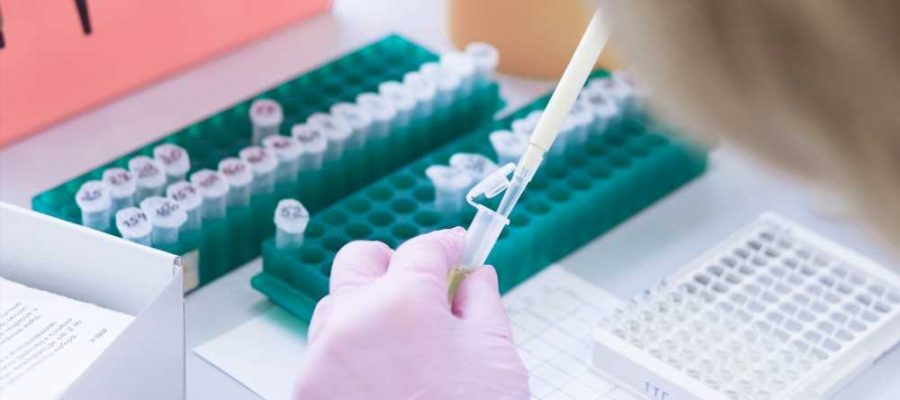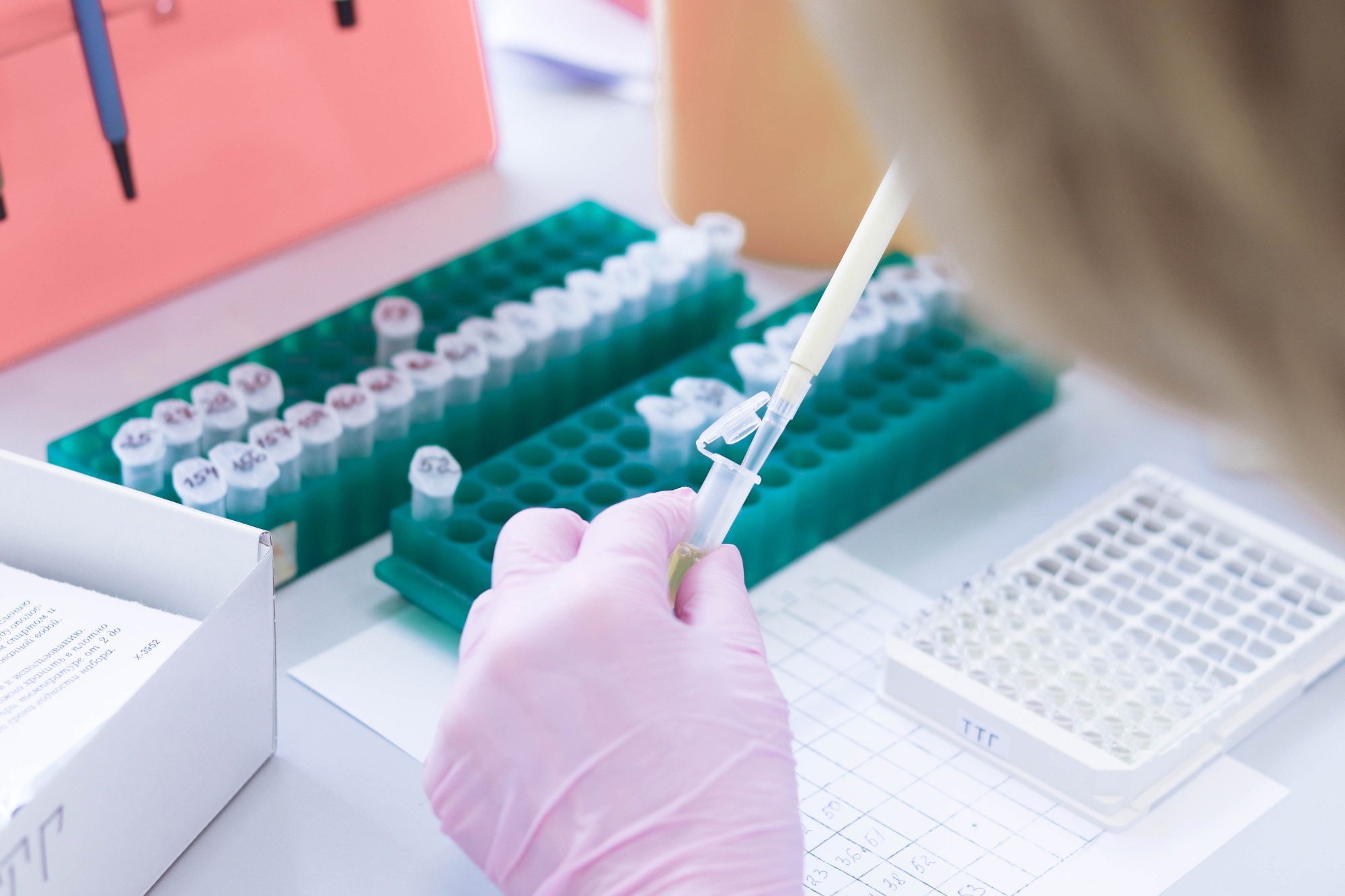
Next-generation ovarian cancer therapy: Engineered Vδ2 T cells show promise in preclinical trials
In a recent study published in Nature Communications, researchers developed CD16Hi Vδ2 T lymphocytes engineered with chimeric antigen receptor (CAR) and interleukin-15 (IL-15), presenting them as a prospective path for allogeneic cellular immunotherapies.
Allogeneic Vδ2 T lymphocytes may treat cancers due to their safety and immunological abilities. However, their clinical efficacy is limited due to donor heterogeneity, short-term survival, and immune evasion.
Although CAR-T lymphocyte treatments show promise in treating hematological malignancies, obstacles such as infiltration barriers, antigen heterogeneity, and immunosuppressive tumor microenvironments restrict their therapeutic advantages.
 Study: Unlocking the potential of allogeneic Vδ2 T cells for ovarian cancer therapy through CD16 biomarker selection and CAR/IL-15 engineering. Image Credit: Tati9/Shutterstock.com
Study: Unlocking the potential of allogeneic Vδ2 T cells for ovarian cancer therapy through CD16 biomarker selection and CAR/IL-15 engineering. Image Credit: Tati9/Shutterstock.com
About the study
In the present study, researchers generated Vδ2 T lymphocytes with improved anticancer activity by screening donor individuals for cluster of differentiation 16 (CD16) expression. The cells exhibited enhanced effector molecule expression and antibody-dependent cellular cytotoxicity (ADCC). Mesothelin-targeted CARs and interleukin-15 use were combined to boost their antitumor potential.
The researchers investigated whether Vδ2 T lymphocytes grown from CD16Hi and CD16Lo donors killed human ovarian carcinoma cells.
OVCAR3 and SKOV3 high-grade serous ovarian cancer cells were generated with dual reporters for firefly luciferase and green fluorescence protein (FG) and cocultured with different ratios of effector cells in zoledronate (ZOL) presence or absence.
Bioluminescence was used to assess tumor cell death twenty-four hours after coculture. A lentiviral vector expressing CD16a was designed for engineering CD16Lo Vδ2 T lymphocytes to express transgenic CD16a.
Bulk ribonucleic acid-sequencing (RNA-Seq) was performed on Vδ2 T lymphocytes grown from 13 individuals who donated peripheral blood mononuclear cells (PBMCs), three of whom were identified as CD16Hi by flow cytometry. Gene set enrichment analysis (GSEA) was performed to assess CD-16-linked biological pathway signatures.
Due to the possibility of multiple targeting, the researchers anticipated that MSLN-targeted CAR (MCAR)–engineered Vδ2 T lymphocytes would have greater antitumor efficacy. They also used cell engineering to create IL-15 (MCAR15).
Further, in vitro cytotoxicity and cytokine production experiments were performed to assess the effector activities of CAR-engineered CD16Hi Vδ2 T lymphocytes.
MCAR15-Vδ2 T lymphocytes cocultured with SKOV3- and OVCAR3-FG cells were tested for intracellular expression of granzyme B and perforin. The researchers concentrated on the canonical lymphocyte CD16a receptor, often known as CD16.
In vitro, tumor coculture tests were performed using a preclinical anti-human epidermal growth factor receptor-2 (anti-HER2) monoclonal antibody (mAb) analog to trastuzumab to examine the ADCC potential of unmodified and engineered CD16Hi Vδ2 T lymphocytes.
Human monocyte-derived M2 macrophages were created by cultivating PBMCs in macrophage colony-stimulating factor (M-CSF) presence, resulting in monocyte-derived macrophages (MDM). The anticancer efficacy and safety of MCAR15-Vδ2T lymphocytes generated from CD16Hi donors were assessed in two xenograft tumor models.
Results
CD16 was investigated as a donor selection indicator to harness Vδ2 T lymphocytes with increased cytotoxicity and antibody-dependent cell-mediated cytotoxicity (ADCC).
CD16 was utilized to identify peripheral blood mononuclear cell (PBMC) donor individuals and Vδ2 T lymphocytes were expanded from donors for developing T lymphocyte-based cancer therapeutics.
CD16 low (CD16Lo) and CD16 high (CD16Hi) Vδ2 T lymphocytes expressed CD16 in proportions of 20% and 35%, respectively. In total, 30 donors were evaluated, with seven (23%) having CD16Hi expression. CD16 levels among CD16Hi Vδ2 T lymphocytes were sustained and enhanced after 14 days of ZOL activation and expansion.
In ZOL presence, CD16Hi Vδ2 T lymphocytes demonstrated considerably increased cytotoxicity at nearly all E:T values evaluated for the cancer cells. After 24 hours of coculturing effector cells and tumor cells in a 1:1 ratio, the enhanced cytotoxicity of Vδ2 T lymphocytes grown from CD16Hi donors corresponded with higher IFN- secretion, granzyme B, and perforin production.
Engineered CD16Hi Vδ2 T lymphocytes may target ovarian tumor cells via ADCC, with considerable tumor killing detected with anti-HER2 mAb doses as low as 0.1 g/mL. During in vitro cocultures, Vδ2 T lymphocytes depended on ZOL for effector molecule synthesis and cytotoxicity.
Chemokine receptor 4 (CCR4), CCR5, and C-X-C motif receptor 3 (CXCR3) levers were consistent at the intra- and inter-donor levels.
The MCAR and MCAR15 designs produced comparable CAR expression, Vδ2 T lymphocyte growth, and Vδ2 T lymphocyte purity, with better than 98% purity regularly obtained. MCAR15- Vδ2 T lymphocytes displayed potent antitumor activity against ovarian tumor cells in vitro.
As indicated by 24-hour cocultures, CAR-engineered T and Vδ2 T lymphocytes produced a large amount of IFN-γ when cultivated with OVCAR3-FG, CAR-engineered T, and Vδ2 T lymphocytes.
After repeated tumor challenges, the MSLN deletion resulted in lower killing by CAR-Vδ2 T lymphocytes in ZOL absence. Through ADCC, engineered CD16Hi Vδ2 T lymphocytes might target ovarian tumor cells.
Through ADCC, engineered CD16Hi Vδ2 T lymphocytes may target ovarian tumor cells, with anti-HER2 mAb doses increasing tumor death against OVCAR3-FG cell lines. Anti-HER2 mAb addition increased the killing effectiveness of MCAR-Vδ2 T lymphocytes against OVCAR3-FG, OVCAR8-FG, and SKOV3-FG cells but did not affect standard MCAR-T lymphocytes.
Conclusion
Overall, the findings highlighted the promising potential of modified CD16Hi Vδ2 T lymphocytes in cancer treatment.
The cells target tumors by recognizing CAR, T-cell receptor (TCR), and ADCC, displaying robust in vivo control and long-term persistence without GvHD symptoms.
Further research is required to investigate T helper 17 (Th17) potential, immunogenicity, and the creation of CD16Hi Vδ2 T lymphocyte pools and to establish significant tumor penetration and long-term therapeutic benefits in treatment-resistant patients.
-
Lee, D., Dunn, Z.S., Guo, W. et al. (2023) Unlocking the potential of allogeneic Vδ2 T cells for ovarian cancer therapy through CD16 biomarker selection and CAR/IL-15 engineering. Nat Commun 14, 6942. doi: https://doi.org/10.1038/s41467-023-42619-2. https://www.nature.com/articles/s41467-023-42619-2
Posted in: Medical Procedure News | Medical Science News | Medical Research News | Medical Condition News | Women's Health News
Tags: ADCC, Antibody, Antigen, Bioluminescence, Blood, Cancer, Cancer Therapy, Cancer Treatment, Carcinoma, Cell, Cell Death, Chemokine, Chimeric Antigen Receptor, Cytokine, Cytometry, Cytotoxicity, Efficacy, Flow Cytometry, Fluorescence, Gene, Growth Factor, in vitro, in vivo, Interleukin, Intracellular, Luciferase, Lymphocyte, Macrophage, Molecule, Monoclonal Antibody, Monocyte, Ovarian Cancer, Perforin, Preclinical, Protein, Receptor, Research, Ribonucleic Acid, RNA, T Lymphocyte, T-Cell, Therapeutics, Transgenic, Trastuzumab, Tumor, Xenograft, Zoledronate

Written by
Pooja Toshniwal Paharia
Dr. based clinical-radiological diagnosis and management of oral lesions and conditions and associated maxillofacial disorders.